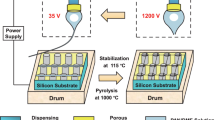Abstract
Carbon nanotubes (CNT) are expected to revolutionize a range of technologies because of their unique mechanical and electrical properties. Using nanotubes in structural materials holds significant promise due to their extremely high modulus and tensile strength, however their cost, production rate and integration into a fiber form severely limit the current structural application opportunities. The high cost of CNT is tied to their slow, batch synthesis using vapor phase, vacuum processes. We report the investigation of the formation of carbon nanotubes from a polymeric precursor using an electrospinning production process. Electrospinning generates nanofibers at velocities up to 10 m/s from a single nozzle without a vacuum requirement, with the potential to generate CNT appropriate from structural and electrical applications. Our CNT formation concept is based upon Reactive Empirical Bond order calculations that show carbon nanofibers have a thermodynamic preference for the cylindrical graphite conformation. Simulations suggest that for small diameter carbon fibers, less than about 60 nm, the single wall and multi wall nanotubes (SWNT and MWNT) phases are thermodynamically favored relative to an amorphous or planar graphitic nanofiber structure. We have developed a novel process using continuous electrospun polyacrylonitrile (PAN) nanofibers as precursors to continuous SWNT and MWNT. The process for converting PAN nanofibers to SWNT’s and MWNT’s follows the process for typical carbon fiber manufacture. The PAN nanofibers, of 10 to 100 nm in diameter, are crosslinked by heating in air and then decomposed to carbon via simple pyrolysis in inert atmosphere. The pyrolyzed carbon nanofibers are then annealed to form the more energetically favorable SWNT or MWNT phase, depending upon the precursor diameter. We will discuss the process and characterization data.
Similar content being viewed by others
References
D. Reneker and G. Srinivasan, “Structure and Morphology of Small Diameter Electrospun Aramid Fibers,” Polymer Int., 36 (1995). Reneker, D.H. and Chun, I., “Nanometer diameter fibers of polymer produced by electrospinning,” Nanotechnology, 7, 216–223 (1996).
S. V. Fridrikh, G. C. Rutledge, “Formation of Fibers by Electrospinning,” Adv. Drug Deliv. Rev. 2007, 59(14), 1384–1391.
D. H. Reneker, {etet al.}, “Carbon Nanofibers from PAN and Mesophase Pitch,” J. Adv. Materials, 31(1), (1999).
S. B. Sinnot, {etet al.}, “Model of Carbon Nanotube Growth through Chemical Vapor Deposition,” Chem. Phys. Let., 315, 25–30 (1999).
K. Kinoshita, Carbon Materials. Carbon - Electrochemical and Physicochemical Properties. Wiley, New York 1988.
D. Tomanek, {etet al.}, “Catalytic Growth of Single Wall Carbon Nanotubes: An Ab Initio Study,” Phys. Rev. Lett., 78(12), 24 Mar 1997. Tomanek, D., Smalley, R.E., et al., “Morphology and Stability of Growing Multiwall Carbon Nanotubes,” Phys. Rev. Lett., 79(11), 15 Sept 1997.
T. Lin, H. Wang, H. Wang, and X. Wang, “The charge effect of cationic surfactants on the elimination of fiber beads in the electrospinning of polystyrene,” Nanotechnology 15 (2004) 1375–1381.
Marquez-Lucero, J.A. Gomez, R. Caudillo, M. Miki-Yoshida, M. Jose-Yacaman, “A Method to Evaluate the Tensile Strength and Stress–Strain Relationship of Carbon Nanofibers, Carbon Nanotubes, and C-Chains,” Small, 1 (2005) 640–644.
J. D. Lennhoff, “Carbon and Electrospun Nanostructures,” US Patent 7790135 B2, awarded Sept. 7, 2010.
J. D. Lennhoff, “Near Field Electrospinning of Continuous Aligned Fiber Tows,” US2012/0086154 A1, published April 12, 2012.
Acknowledgments
This material is based upon work supported by the Defense Advanced Research Projects Agency, Defense Sciences Office under Contract numbers MDA972-02-C-0029 and HR0011- 06-C-0011. TEM studies were performed in the labs of Prof. Yury Gogotsi, Department of Materials Science and Engineering, Drexel University and Prof. Yang Shao-Horn, Department of Mechanical Engineering, Massachusetts Institute of Technology.
Author information
Authors and Affiliations
Rights and permissions
About this article
Cite this article
Lennhoff, J.D. SWNT and MWNT from a Polymeric Electrospun Nanofiber Precursor. MRS Online Proceedings Library 1752, 15–25 (2015). https://doi.org/10.1557/opl.2014.946
Published:
Issue Date:
DOI: https://doi.org/10.1557/opl.2014.946




